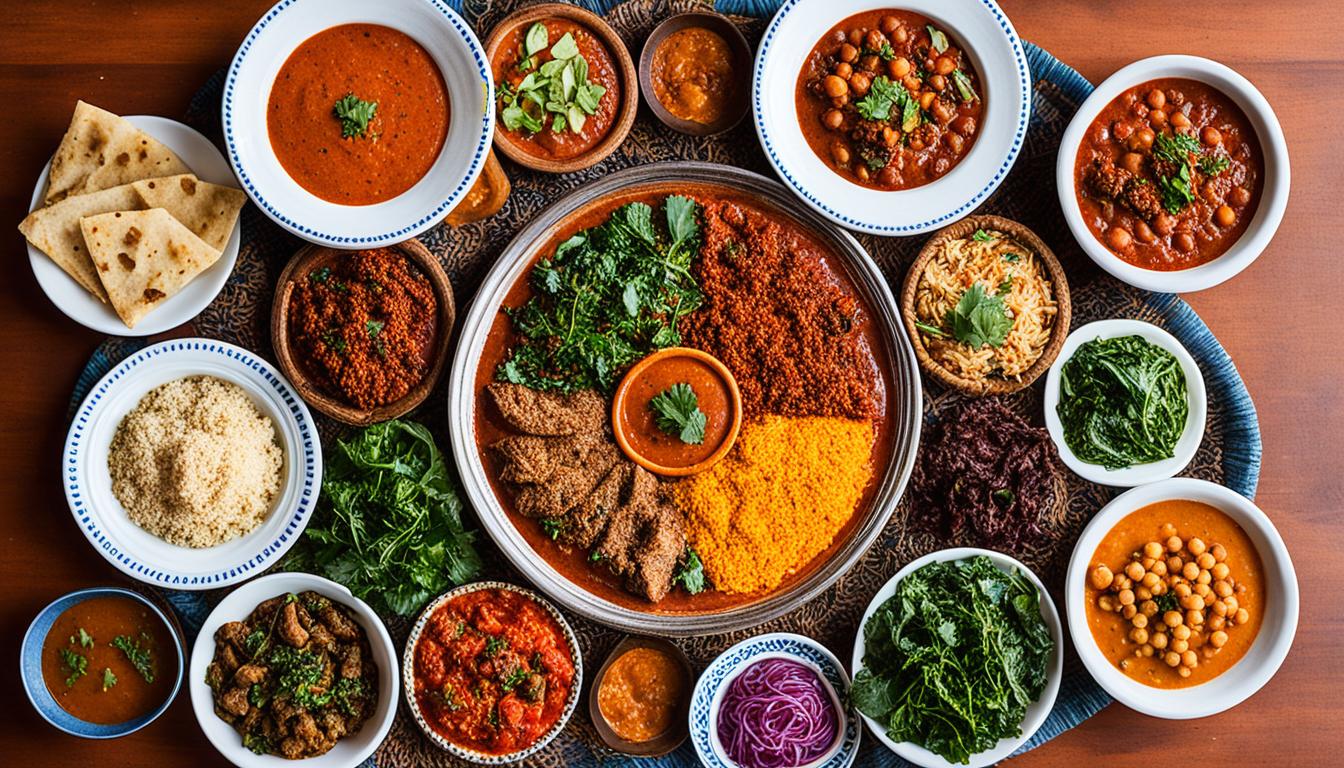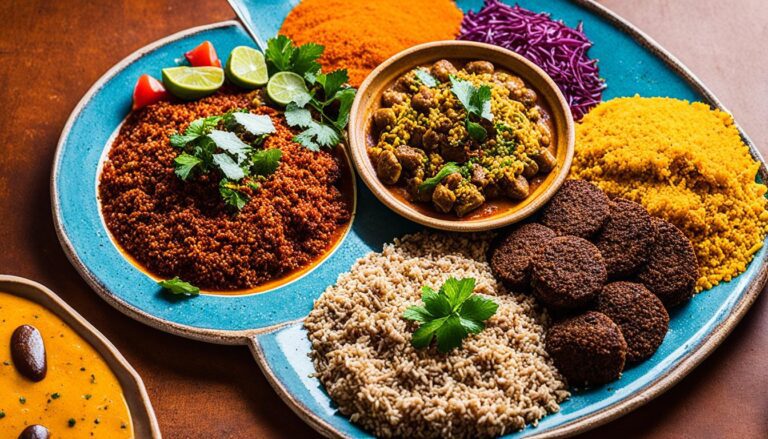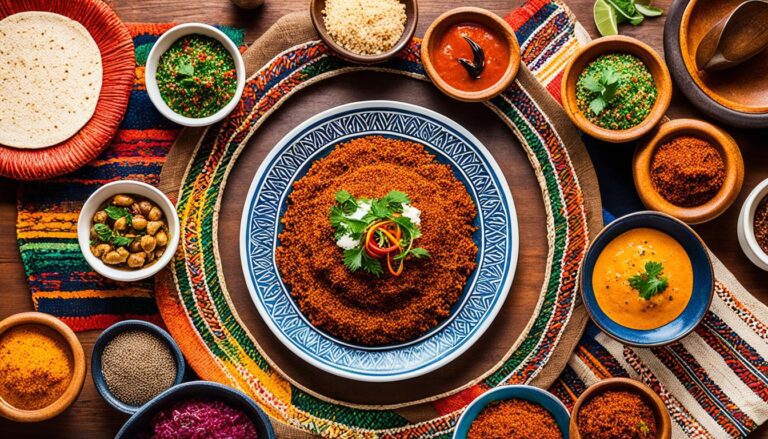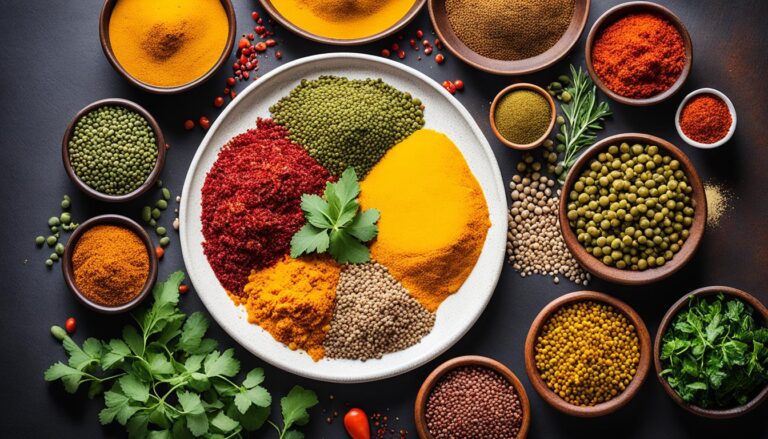What Is a Typical Ethiopian Food?
When it comes to culinary adventures, exploring different cuisines is like embarking on a journey to discover new flavors and traditions. And one cuisine that undoubtedly stands out is Ethiopian cuisine. But have you ever wondered what makes Ethiopian food so unique? What are the typical dishes that define Ethiopian cuisine?
Unlike many other cuisines, Ethiopian food is not just about the taste but also the experience. It reflects the country’s rich cultural heritage and traditions. From the communal dining style to the bold use of spices, every aspect of Ethiopian cuisine tells a story.
Are you ready to unravel the secrets of Ethiopian gastronomy? Join us as we delve into the world of traditional Ethiopian dishes, uncover the flavors of Ethiopian spices, and explore the customs and traditions that make dining in Ethiopia a truly unforgettable experience.
Key Takeaways:
- Ethiopian cuisine is known for its distinctive and delicious dishes, reflecting the country’s unique cultural heritage.
- Injera, a spongy pancake-like bread, serves as the foundation for many Ethiopian meals.
- Berbere, a popular spice blend, adds bold flavors to Ethiopian dishes.
- Communal dining is a significant part of Ethiopian food culture, with everyone gathering around a large tray of injera and using their hands to eat.
- Exploring Ethiopian cuisine provides a journey through the rich culinary traditions of this remarkable country.
Ethiopian Dishes to Try: A Taste of Tradition
Ethiopian cuisine is a treasure trove of delectable dishes that showcase the rich culinary traditions of this vibrant country. From savory meats to flavorful vegetarian options, there is something for everyone to enjoy. Here are just a few examples of the mouthwatering Ethiopian dishes that you must try:
Tibs
Tibs is a delicious dish made with pan-fried beef or lamb seasoned with a delightful blend of butter, garlic, and onion. The sizzling aroma that fills the air as the meat cooks will surely whet your appetite. With juicy and tender bites, tibs is a true delight for meat lovers.
Kitfo
Kitfo is a delicacy consisting of minced and lightly cooked beef mixed with aromatic spices. This dish is bursting with flavor and is typically served rare or medium-rare. If you’re feeling adventurous and appreciate the taste of raw meat, kitfo is a must-try Ethiopian specialty.
Beyainatu
If you’re a vegetarian or simply looking for a flavorful plant-based option, beyainatu is the perfect choice. This dish offers a tantalizing mix of various vegetable curries, lentil stews, and delightful flavors that will leave you craving for more.
Fuul
Fuul is a hearty and healthy fava bean stew, traditionally enjoyed as a breakfast dish in Ethiopia. Packed with protein and spiced to perfection, this dish is a great way to start your day. The combination of tender fuul and injera is a match made in culinary heaven.
Tere Siga
For the adventurous food enthusiasts, tere siga is a unique delicacy worth trying. This dish features cubes of raw red meat, meticulously seasoned and bursting with flavor. If you enjoy bold culinary experiences, tere siga will surely intrigue your taste buds.
These are just a few examples of the incredible Ethiopian dishes that await you. From vibrant spices to tantalizing flavors, traditional Ethiopian food offers a culinary journey like no other. So, don’t miss the opportunity to savor the taste of tradition and indulge in the exquisite cuisine of Ethiopia.
The Flavors of Ethiopian Cuisine: Spices and Seasonings

Ethiopian cuisine is renowned for its use of aromatic spices and flavorful seasonings. These essential ingredients play a vital role in creating the distinct taste and richness of Ethiopian dishes.
One of the most well-known spices in Ethiopian cuisine is Berbere. This vibrant spice blend combines chili powder, fenugreek, ginger, garlic, cardamom, and cinnamon, among other spices. It adds a complex and fiery flavor to various Ethiopian dishes, making them truly unforgettable.
Another popular spice blend in Ethiopian cooking is Mitmita. It is a fiery mix of chili peppers, garlic, ginger, and other spices. Mitmita adds a powerful kick to dishes, infusing them with heat and depth of flavor.
To enhance the taste of many Ethiopian recipes, Niter kibbeh is a secret ingredient. It is a clarified butter that is infused with spices like fenugreek, cumin, and turmeric. Niter kibbeh adds a rich, savory taste to stews and sauces, elevating the overall flavor profile of the dish.
For those who crave an extra punch of flavor, Awaze is the perfect condiment. Awaze is a spicy paste made by blending berbere with oil and either Ethiopian wine or whiskey. It adds a robust and zesty element to a variety of Ethiopian dishes.
These remarkable spices and seasonings are the key to the tantalizing flavors found in Ethiopian cuisine. They bring depth, heat, and complexity to every bite, making Ethiopian dishes a delightful experience for the taste buds.
Ethiopian Cuisine: Eating Traditions and Customs

When it comes to Ethiopian cuisine, it’s not just about the food itself; it’s also about the rich traditions and customs that surround the dining experience. Ethiopian food traditions are deeply rooted in communal dining, creating a sense of togetherness and connection.
Injera, the staple bread of Ethiopian cuisine, plays a central role in this communal dining experience. It is served on a large platter called a gebeta, and everyone gathers around it to enjoy the meal. The injera acts as both a utensil and a food item, as it is used to scoop up various dishes.
Meals in Ethiopia are often shared among friends and family, fostering a sense of community and warmth. There is a beautiful tradition called gursha, where one person feeds another a bite of food as a gesture of respect and love. This act of gursha strengthens the bond between individuals and signifies the importance of sharing and caring for one another.
As we sit together, tearing off pieces of injera and savoring the vibrant flavors of Ethiopian cuisine, we are embracing not just a meal but a cultural experience. The communal and interactive dining style of Ethiopian cuisine adds a unique charm to every gathering, making it an unforgettable experience for both locals and visitors alike.
Conclusion
Experience the rich culinary heritage of Ethiopian cuisine, a treasure trove of flavors that will transport your taste buds on a delightful journey. At the heart of Ethiopian food culture lies injera, a traditional spongy bread that serves as the foundation for a variety of delectable dishes.
The unique flavors of Ethiopia are a result of the skillful use of aromatic spices and seasonings. Berbere, a blend of spices including chili powder, fenugreek, ginger, and garlic, adds a bold and fiery kick to many dishes. Mitmita, another popular spice blend, infuses meals with a tantalizing heat that ignites the senses.
But Ethiopian cuisine is more than just food; it is an interactive experience. Communal dining is an integral part of Ethiopian culinary traditions, where friends and family gather around a large tray of injera, sharing mouthwatering dishes and tearing off pieces of the bread to savor each morsel. This shared experience fosters a sense of togetherness, creating unforgettable memories.
Embark on a culinary adventure unlike any other as you savor the authentic flavors of Ethiopia. From the hearty tibs and kitfo to the vibrant vegetarian options like beyainatu and shiro wat, each bite embodies the rich cultural heritage of this remarkable country. So immerse yourself in the vibrant Ethiopian food culture and let its irresistible flavors whisk you away to a world of gastronomic bliss.







